PRESERVE BELLEVUE
(preservebellevue.com)
Draper, UT
BALLOT REVIEW – LESSONS LEARNED
Prepared by L. Kelly Peterson
Updated 4.4.2021
Thank you for visiting the “Preserve Bellevue” website, a space dedicated to celebrating the principals and ideals found in the Declaration of Protective Covenants (“CCRs”) for one of the most beautiful and desirable communities in Utah, Bellevue of Draper.
After years serving on the Association’s board, I wish to share some general lessons learned, and some perspectives on the proposed CCR changes that will materially weaken core association benefits and significantly impair property values. The views shared here are based solely on my own personal experience, research1, guidance from HOA attorneys2, and an optimistic desire to actively support the protections provided by the existing Bellevue CCRs. Bellevue is a most appealing community and can remain such with positive support by owners and by a management team that actively applies the protections this community promises.
Living in a homeowner association can provide an alternative to sometimes frustrating neighborhood experiences, including contention or even legal conflict that can arise among owners from time to time. Among the benefits of HOA’s, home values often command significant premiums compared to non-HOA governed communities. The protections and safety provided by the Bellevue CCRs are most fitting and a provide a welcomed opportunity to live in a respectful atmosphere set apart from the minimum standards set forth by local municipalities.
WHERE NEIGHBORS OF COMMON INTERESTS CAN BE UNITED
From a reference guide on homeowner association living authored by HOA attorney and legislator, Peter Dunbar1 states, “A homeowners association is designed to preserve the common welfare and property value of the community. It is the cornerstone of a planned residential community and gives it continuity, preserves architectural integrity, and maintains the common area.” The association’s covenants form a contract among owners in the community and wonderfully unifies neighbors to one another, helping to form a community connection that can be more enriching than non-association governed communities.
To achieve these goals, paraphrasing again from Dunbar1, owners have two responsibilities, one to themselves and their individual owned property, and the other to the association of neighbors. The success of the association will depend on how well each member meets and keeps these responsibilities.
WHERE HIGH-QUALITY LIVING IS PROTECTED AND PRESERVED
With regard to our Bellevue CCRs, these have been thoughtfully prepared by expert attorneys in corroboration with the largest, most successful home builder in the State of Utah, which engages with hundreds of municipalities, and which requires a complete understanding of unique local personalities, regulations, and laws. These carefully selected covenants provide wide boundaries, modest restrictions, and are based on practical, experienced-based wisdom in their selection. In fact, they have proven so successful and appropriate that this covenant package is consistent with many other CCRs in like communities.
As an illustration, below is a small sampling of some of the current CCR provisions, along with the benefits and protections they provide to the community. Also included are sample images to illustrate the consequences of the permitted activities with CCR changes.
SAFETY, UNCLUTTERED OPEN STREETSCAPE, BEAUTY, AND DRIVEABILITY
Street Parking Prohibition - Many homeowners seek a neighborhood with this provision in mind coming from previous experiences (myself included) where recurring street parking can become an overwhelming safety hazard, along with a driving and aesthetic distraction, especially with Bellevue’s narrower streets. The association has received parking complaints along with requests for recovery of associated vehicle damage repair costs. Included in the CCRs since 2006, the bullet points below summarize the wisdom of this rule.
- Bellevue’s narrow streets are intentional to “…provide a traffic calming effect”, per the CCRs.
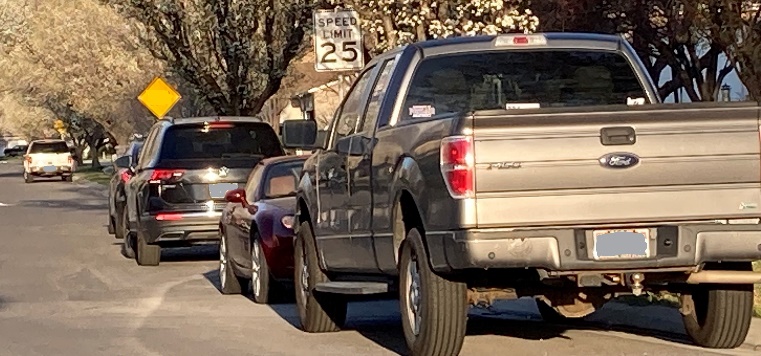

- Promotes obstacle-free streets for driving – particularly when dark or around corners and near intersections. Draper City now prohibits street parking with snow on the ground or within 30 feet of the curve-end of any corner or the top of a T-intersection (Draper City 14-5-010).
- Provides for vehicle passage otherwise impassable with cars on both sides.
- Significantly reduces propensity for property and vehicle damage.
- Provides increased pedestrian and play safety.
- Eliminates possible emergency and delivery vehicle impairment.
- Significantly reduces vandalism and theft – especially of late.
- Provides a means of detecting possible neighborhood crime.
- Owners already have been provided at least 4 on-property parking spots, most have 6 and some 8 or more. Homeowner notices to date for street parking have shown mostly empty driveways.
- Avoids inconveniencing a full street of owners.
- An allowance for temporary visitor parking when driveways are full or for service vehicles can be managed through CCR administration. Bi-weekly monitoring should be adequate to manage habitual non-compliance.
A SANCTUARY FREE OF DISTRACTING OR CONTROVERSIAL/OFFENSIVE MESSAGING
Signs and Advertising Restricted - Except for a single property sale display not greater than 2ft.X 2ft. and the statutory exception of an allowance to temporarily “display religious and holiday signs, symbols, and decorations inside a dwelling” (reference Utah Code 57-8a-218 (3 and 4), this rule provides a number of important benefits and avoidance of the following:
- Signs can be a visual distraction – considered by many to be unsightly.
- Avoids signs left for days, weeks, or months outside.
- Wisely prohibits advertising for business services in a residential neighborhood.
- Eliminates the need for monitoring or addressing content deemed offensive by other neighbors.
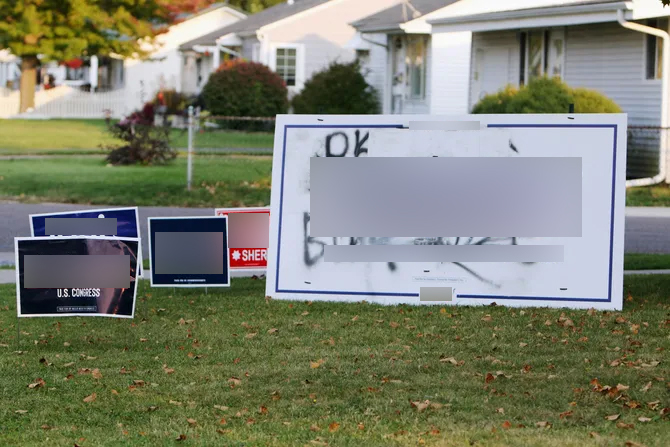
“…Yard Signs Are Targeted For Theft And Vandalism.” - wasbtv.com (Sign content has been blurred)
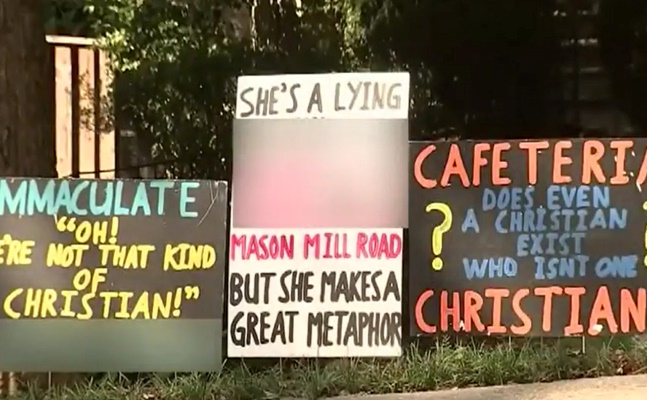
“Residents Fed Up With Neighbor’s Controversial Lawn Signs and Displays” - thehawkeye.com (Some sign content blurred)
- Some referenced has been made to Utah statute stating that an association may “…not regulate the content of political signs”, but the statute does not prohibit the association from their being posted to start with, thereby avoiding possible contention, animosity, or now even possible vandalism over content.
- Promotes a neutral atmosphere and an environment free of frequent and unsolicited demand for attention and messaging.
- Property sale signs larger than 2X2 have been determined to be too large. The standard throughout Utah is a maximum 2X2, in or out of HOAs. Some associations don’t allow property sale signs at all.
RETAINS ELEGANT AND ORDERLY ATMOSPHERE
No Visible Trash or Bins - Visible trash bins tarnish and detract from an otherwise elegant atmosphere, especially when overflowing or with trash which falls outside bins. This restriction also:
- Eliminates the need for additional monitoring for unsightly debris.
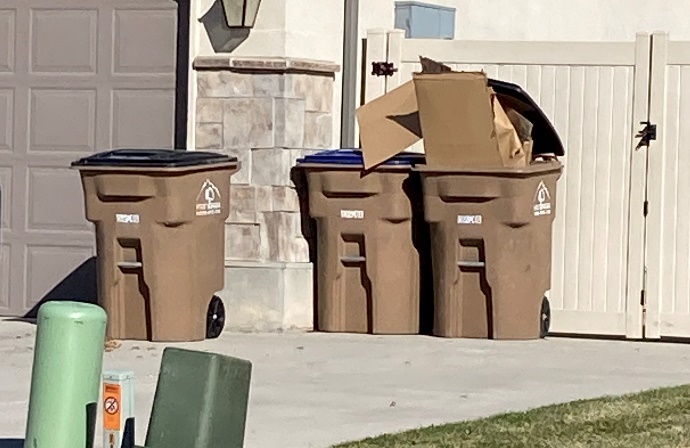
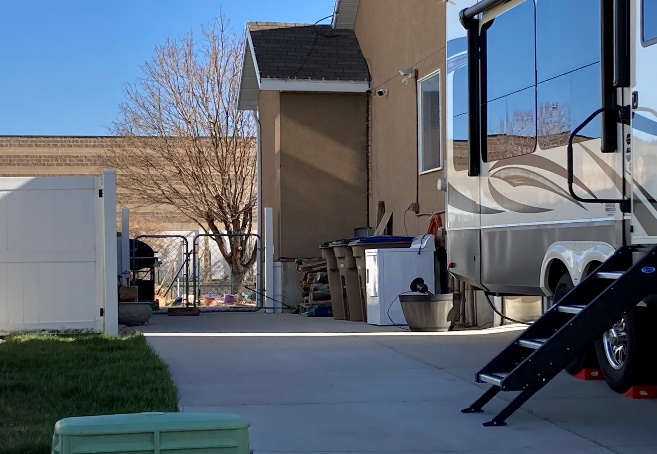
- Provides a signal with large cubic-feet sized bins placed on driveway for upgrades to identify possible ARC request needs. Owners can notify the association and receive temporary allowance in advance.
- Promotes concealment behind see-through grate fencing with decorative trash bin fencing – there are some excellent examples of compliant owners – or tucked further behind the house.
REDUCED NOISE, DOG WASTE, ODORS, AND DISEASE
Pet Allowance - Of the four categories of animals referenced in the CCRs (pets, animals, livestock, and poultry), only two domestic pets are permitted (livestock and poultry are therefore prohibited). This rule finds the best balance between housing density, owner complaints, health safety, and allowing for the benefits provided by domestic pet ownership.
- Bellevue has small lots and cannot adequately accommodate more than 2 per household.
- This mirrors the most common allowance in HOA single family neighborhoods.
- More pets further increase an already-prevalent dog waste problem on public areas and private yards.
- Protects neighbors and the community against foul odors, rodents, insects, predators, and the spreading of communicable disease (see Center for Disease Control website on 2020 increase in reported backyard poultry diseases).
- While some reference to the Draper City allowance of three pets has been made, that boundary limit was determined by a well-reasoned judgement and conclusion by City officials for the broader geography.
- Bellevue’s founder developers gave similar thought and consideration given the community’s density and owner complaints, and wisely concluded that a modestly more restrictive limit is appropriate.
FIXES WALLS, REPLACES TREES, REPAIRS COMMON AREAS, AND PROTECTS THE ASSOCIATION
Budget Approval Process - This provision and the mechanics for implementing assessment adjustments are deliberate, and they thoughtfully address concerns regarding budget management. It is crafted in the most appropriate and practical method for managing the financial affairs of the HOA.
- A recent special assessment (one of only two in 17 years) has prudently created a critical peace-of-mind cushion for aging infrastructure, repair, and pending litigation - not available otherwise.
- It strengthens the association’s now well-funded financial condition.
- Future needs are not always predictable, the community is aging, so there is a process of addressing emergencies, infrastructure replacement, repair, and CCR administration.
- The community can veto with a 50% vote and then revert back to the prior year’s budget.
- Provides for necessary maintenance of trees, infrastructure, turf repair, snow removal, safety, enforcement, and defense, etc. Transparency and choice of wise and experienced Board members is key. Again, constraints are there if needed in extreme circumstances.
- Budget increases, even special assessments, amount to single digit dollars per owner per month, but can have huge positive and necessary impact.
- Dues increases have averaged just $10 per year for the past 10 years.
- Association dues are already very low compared to home values. $20-30 per month to provide a means of maintaining the atmosphere desired of its residents is very modest.
PRESERVE THE HARMONY OF ARCHITECTURE AND LANDSCAPE
Architectural Review Requirements and Restrictions - The purposes for this section is to preserve the architectural integrity of the community and to maintain uniform design and style for improvements made by owners. In addition, these provisions:
- Help ensure safety with the obligation for confirming building permits when required.
- Retain the community’s heavier foliage theme of “Rustic Alpine” vs. desert, or other more limited landscape plans.
- Preserve uniform tree-lined thoroughfares with street-specific species specifications.
- Maintain the guidelines for exterior structure modifications and landscape selection.
- Allow for prompt follow-up by the board to ensure project completion in accordance with ARC approvals.
- Promote ongoing harmony with existing homes and streetscapes and avoids extreme outlier paint schemes or architectural remodels.
ASSOCIATION MANAGEMENT IS KEY TO SUCCESS
The achieve the benefits and avoid the consequences noted above with these and the remaining covenants, the board of directors’ primary responsibility is to “affirmatively1” (proactively) administer and enforce the CCRs and ensure dutiful compliance by association’s members. Board members have an accountability and a duty of trust and confidence, acting in the best interests of all owners and therefore must be careful to avoid personal bias or agendas. These board duties provide a welcomed and positive method for ensuring that all owners equally receive the full benefits and protections afforded association owners.
“TO GET WHAT YOU EXPECT, YOU MUST INSPECT”
The industry standard for association management includes the use of twice monthly site-visits by a third-party management company to independently observe exceptions. Temporary or modified site visit protocols may be necessary to address owner-complaint focus areas. As the saying goes to achieve any target or goal, “to get what you expect, you must inspect.” Reasonably frequent site visits maintain positive relations among neighbors and provides the least confrontational method of administration.
Of course, homeowners themselves may also alert the association of other neighbor’s non-compliance (or for any other reason) and may seek redress to the association as needed. Owners should be able to trust that concerns will be taken seriously and be confidential. But, relying too heavily on homeowner complaints alone puts a more aggressive “class” of neighbor at an unfair advantage over another, and may lead to frustration, undue delays, confrontation, claims of selectivity, and potential legal expenses. In extreme cases, this can lead to intimidation or neighbor bullying. Even when complaints are anonymous, over reliance on individual owner enforcement unnecessarily raises suspicion in a relationship between otherwise friendly neighbors.
Neighbors can feel comfortable to associate with one another, even though one might be affected by the non-compliance of another, safely understanding that a matter of non-compliance will be managed by the association.
BEST POSSIBLE LIVING EXPERIENCE FOR ALL
In summary, Bellevue is a marvelous and beautiful community and is governed by a sound document meant to provide the best possible living experience for all.
Thank you for taking the time to review these thoughts and analysis. It is hoped that this can provoke some additional thoughts on the current CCRs. their importance, and the critical need to preserve them in their current form without the revisions proposed in the current ballot. This may again be updated from time to time with additional information, images, and commentary. And, I would really like to hear your feedback at preservebellevue@gmail.com.
References:
- “The Homeowners Association Manual” authored by Peter M. Dunbar, Esq. and Marc W. Dunbar, Esq., copyright 2010, fifth edition.
- “Restrictive covenants that run with the land and encumber subdivision lots form a contract between subdivision property owners as a whole and individual lot owners ...” Swenson v. Erickson, 998 P.2d 807, 2000 UT 16, ¶ 11 (emphasis added). “[T]he Declaration governs the obligations of the lot owners...” Swan Creek Village Homeowners v. Warne, 134 P.3d 1122, 2006 UT 22, ¶ 47.